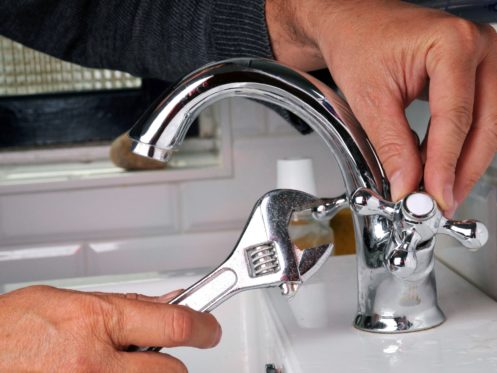
12 Ways To Stop a Leaking Faucet

Have you ever woken up in the middle of the night to a dripping faucet? Or have you come home to find your sink covered in water? If so, you know the frustration of a leaky faucet.
Not only is it annoying, but it can also waste a lot of water. The good news is that you can take some easy steps to prevent your faucet from leaking. Here are 12 tips to get you started.
How To Stop Your Faucet From Dripping
1. Check the Washers
Washers, which are small rubber or metal discs, provide a watertight seal that prevents leaks. Over time, however, washers can become brittle and cracked, allowing water to seep through. By regularly inspecting the washers and replacing them as needed, you can help prevent leaks.
It’s also essential to make sure the washer is the proper size and style for the faucet. If the washer is too small or too big, it won’t create a good seal, and leaks are more likely.
2. Tighten the Screws on the Faucet
Over time, the screws that hold the faucet together can become loose, causing water to leak out. If you notice your faucet is starting to drip, one of the first things you should do is check the screws to make sure they’re tight.
In many cases, simply tightening the screws will stop the leak. If the screws are stripped, you may need to replace them.
3. Make Sure the Faucet Is Aligned Correctly
Everyday use can cause the parts of the faucet to become slightly misaligned, leading to a slow drip. This is an easy problem to fix. Simply unscrew the faucet cap and gently adjust the neoprene washer until it’s appropriately aligned with the seat.
Once you’ve done this, screw the cap back on, and turn on the water to test for leaks.
4. Check for Cracks in the Faucet
Repeated use of faucets can cause wear and tear, resulting in small cracks that can gradually become larger and cause more serious leaks. By inspecting the faucet regularly, you can catch any cracks early and have them repaired before they cause any major damage.
5. Ensure the Water Pressure Isn’t Too High or Too Low
If the pressure is too low, it can cause pipes to corrode and eventually fail. On the other hand, if the pressure is too high, it can put undue stress on fittings and joints, causing them to loosen and leak.
The best way to make sure your water pressure is ideal is to have a qualified plumber install a pressure-regulating valve. This simple device will automatically keep the pressure within a safe range, regardless of any fluctuations in your water supply line.
6. Clear Any Debris That Might Be Blocking the Leaking Faucet
Debris can quickly build up in faucets, especially if you have hard water in your area. This can include anything from dirt and sediment to mineral deposits. If these things are blocking the flow of water, it can put extra strain on the seals and joints, eventually causing them to fail and drip.
It’s essential to clear any debris regularly by using a soft brush to gently dislodge any buildup. If the buildup is particularly stubborn, you may need to use a mild cleaning solution. Rinse off the cleaning solution thoroughly afterward to avoid damaging the finish on your faucet.
7. Ensure the Shut-Off Valve Is Working Properly
The shut-off valve is under the sink and is responsible for supplying water to the faucet. Over time, the valve can become corroded or damaged, which can cause leaks. By regularly checking the shut-off valve and replacing it if necessary, you can help prevent leaks.
It’s also a good idea to know where your main water shut-off valve is, in case of an emergency.
8. Tighten the Packing Nut on the Stem of the Faucet
A packing nut is located under the faucet’s handle, and it’s used to tighten or loosen the stem. Water will leak out around the stem if the packing nut isn’t tight enough. Similarly, if the packing nut is too tight, it can cause damage to the stem and may eventually lead to a leak.
Therefore, it’s essential to find the right balance when tightening the packing nut.
9. Replace the Gasket on the Dripping Faucet if It’s Old or Worn Out
The gasket is a small rubber ring that fits between the handle and the base of the faucet. Over time, the gasket can become hard and brittle, and it may no longer provide a snug fit. As a result, water can leak past the gasket and into the handle, causing the faucet to drip.
Replacing the gasket is a relatively simple process, and it’s an inexpensive way to fix a leaking faucet. Simply remove the handle, unscrew the old gasket, and screw on a new one.
10. Check for Leaks in the Pipes Leading to the Faucet
The seals around the pipe joints can degrade, causing water to seep out. You can prevent this by regularly checking for leaks. There are a few different ways to check.
First, you can look for any wet spots on the ground around your faucet if it’s outdoors. If you see any, there’s likely a leak in your pipe. You can also listen for any dripping sounds coming from your faucet. If you hear any, there’s also likely a leak.
11. Confirm the Water Isn’t Freezing
If the water in the pipes freezes, it expands and puts pressure on the pipes, which can cause them to break or leak. This is especially true for older homes with copper or galvanized steel pipes.
Keep the thermostat set to at least 55 degrees Fahrenheit, and insulate exposed pipes in unheated areas to prevent the water from freezing.
If you know there will be a cold snap, let a trickle of water run from each faucet overnight to keep the water flowing and help prevent freezing. Taking these precautions will help you avoid a costly repair bill down the road.
12. Make Sure There’s No Corrosion on the Leaking Faucet
Corrosion on the faucet can result in small crevices or cracks forming, which will allow water to seep through and cause a leak. Corrosion can also cause the sealant around the faucet to break down, creating another potential avenue for leaks.
You can remove corrosion by using a gentle cleanser and a soft cloth. If the corrosion is extensive, you may need to use a specialty product designed for removing corrosion from metal.
Stop Your Faucet From Dripping With Beyond Wow
At Beyond Wow, we’re the solution to your Austin, TX, faucet needs. Our services include leak detection, slab leak repair, drain cleaning, and hydro jetting. We’re experts in the field and can provide the best possible service.
We also offer a 100% satisfaction guarantee to be sure you’re getting the best possible value for your money.
Contact Beyond Wow today to get your faucet serviced.
Ready for Out-of-This-World Plumbing Service?




